
Goofing around with the ringneck pheasant cape I got in the mail today from a friend who recently returned from a successful hunt in South Dakota.
Another month is upon us and while late fall/early winter is a great time to start tying up some patterns to restock the fly boxes depleted by another year on the water, lets not abandon the fishing quite yet. I have had several great days on the river this past month. It does get a bit hit and miss as the weather and the water temps cool but when you hit it right the fishing can be outstanding. I have still been running into some great baetis hatches around here and so with that in mind I thought I would share my favorite pattern when fish are sipping the Blue Winged Olive Duns off the rivers surface. This pattern is basically a Sparkle Dun with a biot body, and I use a CDC feather for the trailing shuck instead of Z-lon. I like the Sparkle dun because it is so versatile. I think fish feeding on emergers, duns, and spinners could all find a reason to take a well placed Sparkle Dun. This version is quite simple to tie, it floats well, and is fairly easy to see even in the small sizes that will often be required. Lets get started with the materials:
Hook: #18 or smaller Tiemco 100 or equivalent dry fly hook
Thread: Olive 8/0
Wing: Olive Deer Hair
Tail/Shuck: One Natural Brown CDC feather
Body: Gray Olive Turkey Biot
Thorax: Medium Olive Fine Dry Fly Dubbing
1) In the winter months the bugs that do hatch tend to be small. For our rivers in Southeast Idaho I usually tie this pattern in sizes from #18-#24. You can definitely go larger or smaller if needed.
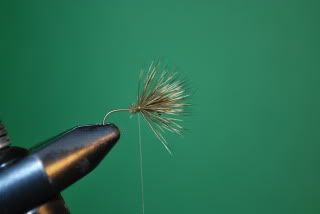
2) Tie in a clump of deer hair about 2/3 down the shank of the hook. I make about 3 good turns while holding the back of the hair so it stays on top of the hook while the tips flare out. Then clip the backs as close as you can at a 45 degree angle.

3) Next I pull up about 1/3 of the hair and make a wrap in front of it, then proceed to pull up another third, again making a wrap in front of that, then finally pull the remaining hairs straight up and wrap in front so that all the hair is standing up on the fly. Then be sure to build up a good thread dam in front of the wing as if you don’t, when the fly gets wet the wing will lean forward on you. Then wrap the thread back to behind the wing and tie down the loose ends on that side.
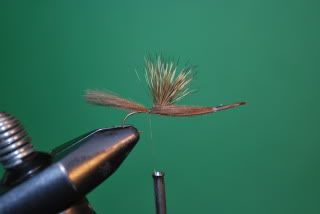
4) Now tie in the CDC feather on top of the hook shank. I don’t worry about how long the tail sticks out as I cut it later.
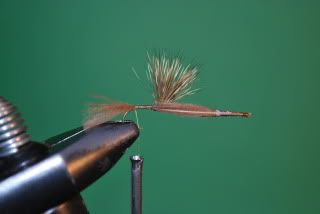
5) Continue securing the CDC feather wraping back to where the shank meets the bend.

6) Now I trim the tail to about 3/4 hook shank length.
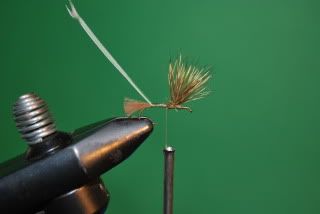
7) Next tie in a Goose or Turkey Biot Quill with the notch facing left. Advance the thread to just behind the wing.
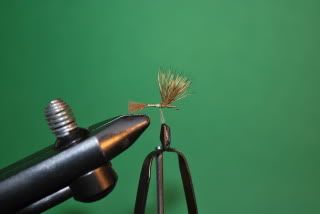
8) Wrap the biot using nice even wraps toward where you stopped the thread, then tie it off and clip the excess.

9) Next I simply dub a nice football shaped thorax using 2-3 wraps behind the wing and 3-4 in the front of it.
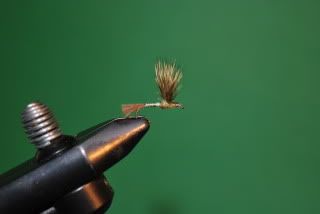
10) Finally make a nice even thread head and tie off the fly. Dab some head cement on there and you are ready to fish.
Play with the color scheme to match other mayfly hatches in your area as well. I like this pattern tied in appropriate colors for the summertime PMD hatches too. Most of all have fun and catch some fish!
I fish it a variety of ways. Often I will fish it with a double nymph rig as the bottom fly fishing it deep with the aid of split shot. In the spring I like to use it as a dropper off an adult Skwala Stonefly pattern on rivers that have that hatch and fish it in the top foot of the water column. It will work all year I am sure but my focus during the summer seems to shift to the many other hatches that take place and my use of this midge pattern takes a back seat.
Midges though are a popular winter staple for trout as they do hatch in many locations all year. Even on a cold winter day, the mid day sun can warm things up enough to bring about a midge hatch that will bring even the most lethargic of cold blooded trout to the surface.
This pattern is basically a Zebra Midge with a few slight modifications. It’s simple to tie, and has for the last couple years been my top fish catching pattern on a variety of rivers.
Figure 1-I usually tie this pattern on hooks size #18 or smaller. This one is on a #18 TMC 2457.
Figure 2-Push a 2mm nickel bead onto the hook.
Figure 3-Lay a base of black thread then I tie in a short tail of a few grizzly hackle fibers. Midges do not have a tail like a mayfly but I tie this with a few fibers at the end as I like to think it gives a little wiggle to the end of the fly.
Figure 4 – Tie in a short section of fine silver wire and advance the thread to the head of the fly building a slight taper with the thread as you go.
Figure 5 – Make evenly spaced wraps with the wire up to the head and tie off with the thread.
Figure 6 – Tie in a small loop of Iridescent Krystal Flash. Then whip finish and drop some head cement on the head and a little on the body of the fly.
Figure 7 – The finished product.
As luck would have it though, this stretch we were fishing happened to be a nice bend in the river that was just slightly sheltered from the wind. The wind was still blowing harder than I would have liked, but it was more manageable here. In this single length of river there was actually a decent hatch of midges and a smattering of Mahogany’s coming off and quite a few fish noses up peppering the surface. The midges were tiny, a pattern somewhere around size 26 would have probably done a fair imitation, and the Mahogany’s where sparse enough I was fairly certain that wasn’t what all the risers were after. I decided to go with a nymph rig with a bead head pheasant tail as my top fly to try to catch those fish looking for the Mahogany nymphs and a small Zebra Midge pattern for my bottom fly. Sure enough this was the ticket. It took one cast to hook into a nice 18 inch brown that took the Zebra Midge. It was just the beginning of one of my better days on this river.

The First fish of the day through a dirty camera phone lense
The Mahogany hatch did not last long as the wind was still a factor but while it was on I did catch two fish on the pheasant tail nymph. After about a half hour I did not see another mayfly and the rest of the fish I caught all took the midge pupa imitation.
The air temps where chilly and the wind didn’t help take the chill off, but with the fish eating constantly it helped take the edge off the weather. With 11 fish on the day I was determined to make it an even dozen and with the action as steady as it had been I figured I wouldn’t have to wait long. Sure enough, as the sun dipped quietly over the horizon, so dipped my indicator slowly under the rivers surface and another big trout took the tiny zebra midge. The chill was reaching bone deep and I knew this was going to be the capper on the day. I brought in a perfectly proportioned 20 inch brown much quicker than I would normally try and horse it in, and released it swiftly back into the frigid water. As we walked back to the truck my lower legs felt like lifeless blocks of ice but the smile on my face made up for that. It was another fine day on the water.



Let's run a little test here. Does my wife read the blog? Lets find out. Here's a short list of what I want for my birthday:
The second item on my wish list, the book "Bugwater" by Arlen Thomason is not set to be released until January 2010 but I am looking forward to it. They have some excerpts from the book on the Amazon page and it looks very interesting. I have also read many of the authors contributions on one of my favorite fly fishing websites, "Westfly," and I can't wait to get my hands on this book.
Here is an example of a post he made there regarding the October Caddis. You can tell he has put some time into his research.
It is getting the point to where the bugs fascinate me almost as much as the fish that eat them. So go ahead and call me a bug nerd. That's OK because I have a long way to go. I still haven't started referring to them by their Latin names.
 Exhibit A, the Rusty Spinner
Exhibit A, the Rusty SpinnerI always wanted to try fly fishing but didn't want to fork over the cash necessary for my conversion. Then 5 years ago I got a fly rod for my birthday and it has been downhill ever since.
It started innocently. I was content fishing easy waters where you didn't even have to think about what was hatching. Just tie on a big foam hopper and throw it around the river and catch fish. It was fun and believe me it still is. I enjoy this type of fishing to this day. Then I started using nymphs but had little idea why they worked, I just knew they did. Then it was streamers which seemed a little like a reversion to my spin fishing days. Fishing streamers still is one of my favorite methods though because of some of the epic takes.
Then about a year ago I slipped deeper into the black hole. I bought my first set up for tying my own flies. This led to some exhaustive research on the bugs fish eat and how to imitate them with feathers and fur. It was not until I started tying my own flies that I truly started to get a grasp of what fly fishing was about. There are so many aspects to it, it is not just tying on whatever is in your fly box and hoping that is what fish are eating. Fish will tip their hand more often than not, but it is always a cat and mouse game. You CAN get lucky but you elevate your chances of success by having a little knowledge on your side.
So I guess it is time to face the facts. I must accept what I have become. A fly flinger that turns over rocks and examines strands of algae searching for signs of bug life. It's been a rather rapid journey but 5 fly rods later and with a fly box full of over 200 mayfly emerger patterns alone I can admit it, I am a fly fishing nerd. Mind you not as big a nerd as some, but I will get there someday, you will see.
 I understand this is not an unheard of journey for a fish that has very close relatives (Steelhead)that routinely travel multiple river systems and thousands of miles to reach their spawning grounds. However it did give me a new perspective on the fish I catch and where they really live. Probably not in one specific hole.
I understand this is not an unheard of journey for a fish that has very close relatives (Steelhead)that routinely travel multiple river systems and thousands of miles to reach their spawning grounds. However it did give me a new perspective on the fish I catch and where they really live. Probably not in one specific hole.








